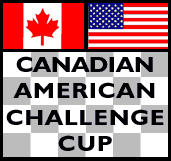Can-Am Challenge Cup

The logo of the Can-Am Challenge Cup
|
|
| Category | Sports car racing |
|---|---|
| Country | United States, Canada |
| Inaugural season | 1966 |
| Folded | 1987 |
The Canadian-American Challenge Cup or Can-Am, was an SCCA/CASC sports car racing series from 1966 to 1987.
Can-Am started out as a race series for group 7 sports racers with two races in Canada (Can) and four races in the United States of America (Am). The series was initially sponsored by Johnson Wax. The series was governed by rules called out under the FIA group 7 category with unrestricted engine capacity and few other technical restrictions.
The group 7 category was essentially a Formula Libre for sports cars; the regulations were minimal and permitted unlimited engine sizes (and allowed turbocharging and supercharging), virtually unrestricted aerodynamics, and were as close as any major international racing series ever got to have an "anything goes" policy. As long as the car had two seats, bodywork enclosing the wheels, and met basic safety standards, it was allowed. Group 7 had arisen as a category for non-homologated sports car "specials" in Europe and, for a while in the 1960s, group 7 racing was popular in the United Kingdom as well as a class in hillclimb racing in Europe. Group 7 cars were designed more for short-distance sprints than for endurance racing. Some group 7 cars were also built in Japan by Nissan and Toyota, but these did not compete outside their homeland (though some of the Can-Am competitors occasionally went over to race against them).
SCCA sports car racing was becoming more popular with European constructors and drivers, and the United States Road Racing Championship for large-capacity sports racers eventually gave rise to the group 7 Can-Am series. There was good prize and appearance money and plenty of trade backing; the series was lucrative for its competitors but resulted, by its end, in truly outrageous cars with well over 1,000 horsepower (750 kW) (the Porsche team claimed 1,500 hp (1,100 kW) for its 917/30 in qualifying trim), wings, active downforce generation, very light weight and unheard of speeds. Similar group 7 cars ran in the European Interserie series, but this was much lower-key than the Can-Am.
...
Wikipedia
